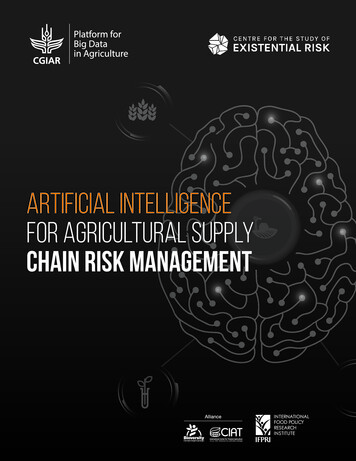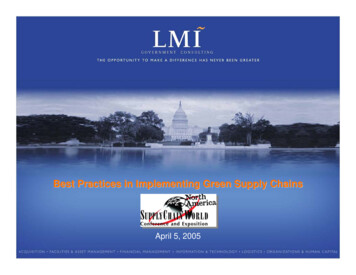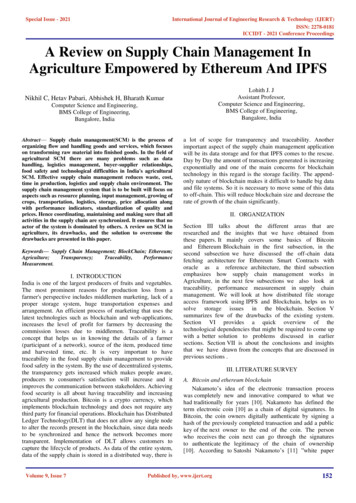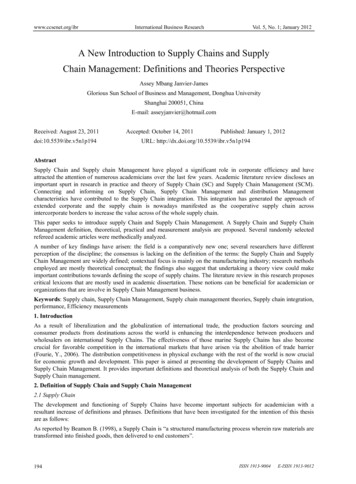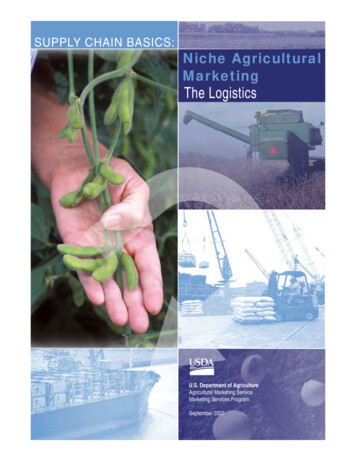
Transcription
SUPPLY CHAIN BASICS:Niche AgriculturalMarketingThe LogisticsU.S. Department of AgricultureAgricultural Marketing ServiceMarketing Services ProgramSeptember 2007
SUPPLY CHAIN BASICS:Niche AgriculturalMarketingThe LogisticsTamara VanWechel, Kimberly Vachal, andMark BerwickUpper Great Plains Transportation InstituteNorth Dakota State UniversityFargo, North DakotaU.S Department of AgricultureAgricultural Marketing ServiceMarketing Services ProgramSeptember 2007i
ContentsSelling to Niche Markets1Niche Agricultural Marketing Logistics2Moving Food-Grade Soybeans.2Marketing Organic Potatoes.4Marketing Dehydrated Potatoes.7Marketing GMO-Tested Potato Products for Export.8Resources for Marketing NicheAgricultural Products10Marketing.10Value-Added.10Transportation and Logistics.10Transportation Rates.11Other Transportation Links.12Glossary14IllustrationsFIGURE 1. Quantity of non-bulk agriculturaltransportation.2FIGURE 2. Comparison of transportation costs for bulkand commodity soybeans.3FIGURE 3. The organic seal.5FIGURE 4. Top eight fresh organic fruits andvegetables purchased by U.S. consumers.6FIGURE 5. U.S. organic food category share, 2005.6FIGURE 6. Cost of shipping, by quantity.7iii
Selling to NicheMarketsMany small and mid-size farm operators competesuccessfully in today’s agricultural marketplaceby supplying specialty farm products. Growingnumbers of consumers and commercial buyersare interested in purchasing farm products withspecific qualities. These customer preferences maybe as simple as a request for a specific volumeof product, such as requiring a 20-metric-toncontainer of grain rather than a 40,000-metricton bulk vessel—the typical size of an overseasgrain shipment—or it may be as complex as aset of specific practices for growing, processing,packaging, and merchandising a farm item, as is thecase with organically labeled farm products. (Formore information, see “Organic Certification” onpage 5.)Other characteristics that differentiate “niche” farmproducts from mainstream farm products are:The local food movement is being buoyed bya host of social, economic, and environmentaltrends, including a desire to obtain fresher,higher quality food in season; to know exactlywhere one’s food comes from and how itwas produced; to reduce fossil fuel usage infood transport; and to support the continuedeconomic viability of local agriculture.Mainstream bulk commodity markets favor largeragricultural suppliers that can take advantageof economies of scale to supply agriculturalproducts at the lowest cost. Niche markets, onthe other hand, are less price-sensitive than bulkcommodity markets and often reward farm productsuppliers with a price premium for their ability tomeet stringent requirements. Small and mid-sizesuppliers that can meet the volume requirementsand precise specifications of niche markets canoften find a good fit for their limited productioncapacity. Moreover, these suppliers often are moreflexible than their larger competitors and more ableto quickly adjust their production practices to meetshifting customer demands. Specific physical characteristics, such asfood-grade soybeans compared with standardfeed-grain soybeans, and high-oil sunflowerseeds compared with standard sunflower seedvarieties. Physical properties proved by testing, suchas foods confirmed to be free of geneticallymodified organisms (GMOs). A farm product’s point of origin, especiallylocal origin. In recent years, U.S. consumershave exhibited a growing interest in purchasingfarm products from local sources, with theresult that the value of farm goods sold directlyfrom producers to consumers through farmersmarkets, roadside stands, community-supportedagriculture arrangements, and other outletsincreased 37 percent between 1997 and 2002. 1. Market Value of Agricultural Products Sold, Including Landlord’s Share, Direct, and Organic: 2002 and 1997,2002 Census of Agriculture, National Agricultural Statistics Service, U.S. Department of Agriculture, availablefrom s/index1.htm.To properly maintain the integrity of niche farmproducts throughout the supply chain and tomeet customers’ exacting standards, suppliersof such products must use specialized sorting,handling, shipping, and transportation methods.This document provides small and mid-sizedagricultural producers and processors with anoverview of the special logistical requirementsthat highly differentiated farm products require. Itgives examples of the logistical requirements forhandling and shipping three different niche farmproducts—food-grade soybeans destined for theJapanese export market, organic potatoes destinedfor the domestic market, and GMO-free dehydratedpotatoes destined for the Asian export market.1
Niche AgriculturalMarketing LogisticsHere is an example of how niche marketingrequirements affect grain handlers and shippers inthe case of food-grade soybeans.Moving niche products from farm to market is morecomplex and expensive than moving conventionalfarm products. The smaller volumes handled andthe need to keep niche products separate frombulk commodities add to the cost of handling andshipping. For example, producers of niche grainsmust arrange to have their niche merchandiseblended, sorted, and cleaned separately fromthe undifferentiated version of the same grain topreserve the products’ distinctive character. Thishandling is typically more expensive than for bulkgrains because it is done in smaller batches andmay require additional equipment preparation. Inspite of the greater cost, the shipping of non-bulkgrains has been increasing rapidly (Figure 1).Moving Food-Grade SoybeansThe United States has supplied food-gradesoybeans to Japan for decades. Advancements ingrain market communications and transactions,along with the advent of shipping containers anddouble-stack rail systems, made the Japanesemarket a viable outlet for United States producers.The niche demands in this market include specialvariety selections, production protocols, andconditioning techniques. Post-harvest practicesinclude computerized sorting to meet colorrequirements, and packaging in customer-labeledtotes and bags.FIGURE 1. Quantity of non-bulk agricultural transportationNon-Bulk Agricultural Exports2.0520-Foot Containers URCE: Port Import Export Reporting Service (PIERS)—Journal of Commerce22005
To get started in the export trade, the producermust locate a market for food-grade soybeans,which may be a customer in Japan or a local brokerwho acts as an intermediary between the producerand the Japanese buyer. The producer then selectsthe soybean variety and pest- and weed-controlpractices to suit the requirements of the customer.When the crop is mature, the producer moves it toon-farm storage or to a local elevator. Dependingon their location, some food-grade soybeanproducers have the option of using a nearbygrain elevator that specializes in serving nichegrain markets, or one that divides its operationbetween conventional commodity and niche grainmarketing. Such storage elevators segregate, ratherthan merge, batches of grain based on variety orgrowing practices, which allows product integrityto be preserved and improves traceability withinthe supply chain.Packaging and transportation are then arrangedto meet the agreed-upon delivery window. Thesoybeans are packaged according to customerrequirements, typically in 100-pound bags on thefarm or at a local elevator. More recently, a systemhas emerged to move food-grade soybeans inbulk lots to transload facilities near the port. Thesoybeans are moved by truck to a hopper railcar,and by railroad to the transload facility, where theyare bagged and loaded into containers, eliminatingthe need for inland container movement.pound (Figure 2), but is the only way to shipcomparatively small amounts of food-gradesoybeans without mingling them with differenttypes of soybeans, such as varieties used for oil.FIGURE 2. Comparison of transportation costs for bulk andcommodity soybeansExport: Commodity and Food-Grade Soybeansfrom Iowa to Japan, via SeattleEstimated Transportation Cost and TimeFood 0119,070,000Inland cost 875 2,160,000Ocean cost 2,000 2,700,000Total cost 2,875 4,860,0001640 0.07 0.02Shipped byVolume (pounds)Transit Time (days)Cost per poundSOURCE: Upper Great Plains Transportation Institute, Fargo, NDTransportation for moving containers to a portmay be secured by the producer or grain facilityfrom the ocean carrier in a service contract, or itmay be handled by a third party. The variety oftransportation arrangements available to marketersof niche farm products is described more fully in alater section titled “Shipping Alternatives.”Shipping soybeans in containers provides securityand prevents co-mingling and contaminationwith other types of soybeans. Using containersmore than triples the transportation cost per3
DESIGNER FEEDSAlthough buying animal feed in bulk markets isas simple as selecting the lowest bid for corn, amore complex niche market has emerged thatproduces designer feeds formulated to improveanimals’ production of meat, milk, wool—orspeed, in the case of race horses. The feedindustry has undergone much consolidationin recent years, and is now dominated bya handful of large companies that use theireconomies of scale to produce and distributefeed inexpensively. While this has created anefficient marketing system for mass-producedcommodity feeds, it has also allowed somesmaller companies to take advantage of theirflexibility to create a niche market. In somecases these companies not only processproducts to meet designer feed specifications,but contract with growers for specific feedcomponents.These small-scale plants condition and mixproducts to strengthen characteristics suchas nutrition, energy content, palatability,and digestibility based on customer goals. Arecent industry survey shows that 67 percentof livestock producers are requesting specificingredients and custom blending. Twoexamples of specialized feed markets areorganic feeds—a requirement for organic milk,egg, and meat production—and a premiumoats market that has developed within theracehorse industry.2. Feedstuffs, July 11, 20053. “Organic sales continue to grow at a steady pace,” Organic Trade Association, May 7, 2006,available from http://www.organicnewsroom.com/2006/05/organic sales continue to grow.html.4. “U.S. Vegetable and Melon Industry: Total Area Harvested and Production, 1992-2005,” 2006Vegetable and Melon Yearbook, USDA Economic Research Service.5. “Certified organic and total U.S. acreage, selected crops and livestock, 1995-2005,” OrganicProduction Data Sets, USDA Economic Research Service, available #tables.4Marketing Organic PotatoesOrganic potatoes represent an excellent example ofniche agricultural products that attain their specialtystatus because of the distinctive production andprocessing methods used to grow them and preparethem for market, rather than because of theirintrinsic physical properties. Given the relativelysmall scale of U.S. organic potato production, andthe need to preserve product integrity througheach link of the supply chain to retain marketvalue, the practices that are used to handle,distribute, and market organic potatoes are oftenquite distinct from those used with conventionallygrown potatoes. Consequently, an examinationof the organic potato industry provides a valuablelesson about steps that growers and processorsof organic potatoes—and to a large extent, otherspecialty agricultural items—need to consider whenmarketing their high-value agricultural products todiscriminating buyers.Despite double digit growth in U.S. organic foodsales in recent years,3 the portion of potato acreagedevoted to organic production remains extremelylimited. In 2005, for example, 1.09 million acres ofpotatoes were planted in the United States.4 Of thisamount, fewer than 7,000 acres, or less than0.6 percent of total potato acreage, wereorganically certified.5Most organic potatoes are produced on a smallscale along with other fresh produce in gardenlike settings, but a few farmers produce organictubers on a larger scale in traditional cropland.The process from field to storage is fairlystraightforward. In some cases, it is as simpleas digging the potatoes and placing them incontainers, which are then purchased and pickedup by the consumer.
Potatoes raised in a field by themselves areharvested with a potato digger. Those raised in avegetable-garden setting are dug by hand. Afterharvesting, the potatoes are washed, sorted,dried, and placed in storage. Ordinarily, all ofthese processes are done by hand. Because ofthe size and nature of the market, little advancedtechnology is used. Potatoes unfit for consumptionare disposed of, including potatoes that are green,rotten, or frozen. The sorting is done by visualinspection and hand picking.When it is time to fill orders, the potatoes are takenout of storage and sorted again based on customerspecifications. Finally, the potatoes are manuallyboxed or packaged for customer delivery or pickup.Most potatoes are packaged into 25- or 50-poundboxes and then delivered to local customersin a company-owned vehicle. The customer isgenerally either a local retailer or restaurant. Thepotatoes also may be marketed through naturalfood wholesalers or brokers. Some larger scaleproducers grow organic potatoes specifically forprocessors who make organic chips or frozenpotato products. One such potato chip processor,Kettle Foods, has a line of organic potato chips.Kettle Foods contracts annually with growers.The contract specifies quality standards, such asorganic certification.ORGANIC CERTIFICATIONPeople who produce potatoes that use theUSDA organic seal (Figure 3) must be certifiedorganic by a USDA-accredited certifying agent.USDA’s National Organic Program (NOP)defines organicproduction as “aFIGURE 3. The organic sealproduction systemthat is managed inaccordance withthe [Organic FoodProduction] Actand regulations inthis part to respondto site-specificconditions byintegrating cultural, biological, and mechanicalpractices that foster cycling of resources,promote ecological balance, and conservebiodiversity.”6The Organic Food Production Act of 1990(OFPA) was passed by Congress to set standardsfor organic food. NOP is the regulatory agencythat oversees enforcement of the Act. Organiccertification means that a product has beenproduced, processed, and handled accordingto stringent standards outlined in the Act thathave been confirmed by a USDA-accreditedcertifying agent. The NOP maintains a list ofaccredited certifying agents at http://www.ams.usda.gov/nop/. Farmers who sell lessthan 5,000 of organic potatoes annually arenot required to be certified, but they mustadhere to the national organic standards.More information about organic certification isavailable from USDA’s Agricultural MarketingService at http://www.ams.usda.gov/nop.6. NOP Program Standards, Definitions, available from the Electronic Code of Federal RegulationsWebsite at http://ecfr.gpoaccess.gov/cgi/t/text/text-idx?c ecfr;sid 11fd57b422b6314d866dc4b02f1a101d;rgn div5;view text;node 7:3.1.1.9.30;idno 7;cc ecfr.5
FIGURE 4. Top eight fresh organic fruits and vegetablespurchased by U.S. consumers7RankOrganic Commodity1Tomatoes2Carrots3Peaches4Squash5Leafy vegetables6Apples7Potatoes8Bananas Traceability is important for organic potatoes,just as it is for other fresh produce. For example,an organic potato packing plant located in eastcentral Minnesota processes potatoes for severalorganic potato growers. The warehouse stores,washes, packs, and ships certified organic potatoesto market. To ensure traceability, each lot isplaced in a separate bin and coded by variety andgrower. Quick locks—bag fasteners with space forimprinting—are used to package the potatoes andinclude lot number information used for tracebackpurposes. The traceability procedures used by thisorganic intermediary are similar to those used inthe conventional potato industry.This Minnesota operation is large comparedwith others in the organic potato industry. It usessome of the same technologies in the sorting andpackaging processes that are used with traditionalpotatoes. An automated screen sizer is used to7. Source: “Price Premiums Hold on as U.S. Organic Produce Market Expands,” USDA Economic ResearchService, May 2005, p. 5.remove small potatoes, and an expanding roll sizersorts out three larger sizes of tubers. Damagedpotatoes are pulled out by hand. The potatoesare bagged automatically. This market requirespackage-to-order fulfillment to meet consumerneeds. Small and medium-sized organic potatoesare packaged in 3- or 5-pound bags and largerpotatoes are put into 50-pound cartons for display.Bulk potatoes are sold loose at grocery stores topermit consumers to select individual potatoes.Most of the facility’s products are shipped to retailstores, either directly or through a wholesaler. Inaddition, a small percentage is sold directly fromthe warehouse to consumers.Relatively few organic potatoes are sold torestaurants because of the difficulties involved incommunicating the value of organic ingredientsto food service buyers. Unless restaurants areaccustomed to promoting their use of organicingredients as a marketing tool in their menus andin other forms of advertising and explicitly targetconsumers who are highly motivated to eatFIGURE 5. U.S. organic food category share, 2005Beverages14%Fruit t/Poultry/Other2%Bread &Grains10%Snack Foods5%Sauces/Condiments2%SOURCE: Organic Trade Association: 2006 Manufacturer Survey6
FIGURE 6. Cost of shipping, by quantityShipping Organic Potatoes from California to New YorkEstimated Transportation Cost and TimeUnitPackageTruckloadTrailer on RailcarRefrigerated RailcarVolume (pounds)1045,00045,000180,000Estimated cost per unit 10 4,000 2,100 8,6004544 1.00 0.09 0.05 0.05Transit time (days)Cost per poundSOURCE: Upper Great Plains Transportation Institute, Fargo, NDorganically grown food, restaurateurs havedifficulty passing along to their customersthe increased expense of procuring organicingredients. These costs include both the typicalpremium for relatively scarce organic potatoesover conventionally grown potatoes and thecosts of transporting organic potatoes to thedesired destination in smaller unit sizes thanis usually required for conventional potatoes.Posted above (Figure 6) is a comparative analysisof transportation costs for potatoes shipped fromthe west coast to the east coast in nonbulk andbulk format, which illustrates how easily the costof organic ingredients can escalate in relation toconventional products because of the need to relyon transportation modes that can accommodatesmaller volumes of product.Marketing Dehydrated PotatoesThe majority of potatoes grown in the UnitedStates is sold to processors rather than sold throughfresh market channels. Fifty-seven percent areused for frozen, canned, or dehydrated products,or are made into potato chips, which requires adifferent logistical approach than the fresh potatomarket. To illustrate the logistical requirementsof the processed potato markets, we have chosento describe the operation of a dehydrated potatoprocessor. Sales to the dehydrated potato industrycomprise approximately 10 percent of the U.S.potato market, making it a good example of animportant niche market outlet.At a dehydrated potato facility, fresh potatoes aremade into flakes and then sold as an ingredient tobe incorporated into various further-processed foodproducts. Because dehydrated potatoes weigh only20 percent as much as raw potatoes, it is importantto control the cost of raw materials to keep thesales price of dehydrated potatoes from becomingprohibitively high. Consequently, potatoes usedfor processing dried flakes are typically purchasedlocally to avoid excessive shipping costs, andcosmetically imperfect potatoes are oftenpurchased because they can be procured morecheaply than higher quality products and do notaffect the quality of the final dried product.7
Potatoes arrive on trucks and are moved into theplant through an underground pipe. The freshpotatoes are steam peeled, scrubbed, trimmed,inspected, and sliced before being cooked.Much of the process from peeling to cooking isautomated. After being cooked, the potatoes arericed and dried. When the drying is complete,the resulting paper-like product is ground into aspecified size, from coarse to fine.The final product is bagged and palletized beforebeing moved into storage. When it is ready tobe shipped to the buyer, it is loaded onto trucksin bags or into tank railcars in bulk. Domesticdeliveries are usually shipped by rail in tank carsusing pneumatic unloading. In addition, somebagged product is shipped by truck to bakeries orfood manufacturers to be used as an ingredient insuch food items as pizza dough and soup.The remaining dehydrated potato flakes areexported to foreign—mostly Asian—markets in 22or 50-pound bags. Intermodal container terminalsare used for these export shipments. A commonroute for dehydrated potatoes from Grand Forks,North Dakota, includes trucking the baggeddehydrated potatoes to Winnipeg, Manitoba,followed by shipping them from Winnipeg toVancouver by rail, and then shipping them byocean vessel to an Asian port.Marketing GMO-Tested PotatoProducts for ExportBecause niche agricultural products oftencommand a hefty premium compared withundifferentiated products, customers for nicheproducts typically have substantial leveragein getting their precise specifications met. Aspreviously mentioned, these specifications mayrange from adherence to a particular set of growingand processing methods (confirmed throughinspections) to customized product formulationsand packaging, strict segregation of product in thedistribution process, and—most recently—tests forgenetic purity.In the case of dehydrated potato products, forexample, much of the demand for exports isgenerated by customers in Asian countries.As a rule, these customers prefer to purchasefood ingredients that do not contain GMOs. Toensure these specifications are met, suppliers ofdehydrated potatoes to Asian markets typicallysend their products to domestic laboratories fortesting and confirmation that they are free of GMOsbefore shipping them overseas.Testing potato products for the presence of GMOsprior to export has become common practice inthe past few years, following several incidents inwhich shipments of U.S. dehydrated potato flakesdestined for the Japanese food manufacturingmarket were rejected on arrival after traces ofGMOs were detected. Not only were the suppliersof the dehydrated potato flakes unable to transacttheir sale, they had to pay to have the flakesshipped back to the United States for disposal.The combined transportation costs for sendingthe potatoes to Japan and then back to the UnitedStates, coupled with the loss of income from theexpected sale of a premium product, amountedto substantial losses for the vendors. In additionto the financial loss, the mistakes underminedthe Japanese customers’ trust in U.S. suppliers ofprocessed potato products, and damaged a majormarket outlet for U.S. producers.88. “Snack recalls exacerbate biotech fuss,” Reuters, June 23, 2001. Available from Ag BioTech InfoNethttp://www.biotech-info.net/biotech fuss.html.8
Shipping AlternativesSuppliers to niche agricultural markets typicallysend products to intermediate buyers and endusers by truck, ocean container, or package carrierservice. The decision to use a particular serviceprovider depends on the quantity to be shipped,the distance it has to travel, and the flexibility ofthe customer regarding its arrival time. Althoughthese shipping alternatives are more expensive thanshipping in bulk, research has shown that buyersare usually willing to pay higher prices for nicheproducts that meet their specifications, a factor thathelps to defray the differential in shipping costs.third-party logistics expert that handles multipleshipments of comparable products to the samedestination, a firm can expect to reduce coststhrough load consolidation.Third-party organizations such as shipperassociations, freight forwarders, and non-vesseloperating common carriers (NVOCCs) willarrange transport and customs clearance for smallbusinesses. These organizations allow smallshippers some economies of size, and provideexpertise in negotiating rates and service terms andin managing international transportation.Transportation arrangements for niche agriculturalproducts may be made directly with the carrieror through a third-party organization, such asa shippers association or freight forwarder thathandles transportation arrangements on behalf ofthe supplier. Businesses that manage their ownfreight arrangements typically select a carrierbased on the scheduled delivery time for thecargo, the carrier’s reputation for reliability, thecost of shipping, and its proximity to the carrier’scollection facility.Businesses specializing in supplying smallvolumes of niche agricultural products mightconsider using a third party to arrange reliableand cost-effective transport for many reasons.Transportation, especially for high-volume andinternational markets, is complex, often requiringmultiple carriers in a sequence of transportservices. For businesses not familiar with shipping,it may be advisable to rely on a service providerto make transportation arrangements, especiallyfor businesses that routinely ship less than afull truckload or container load. By turning to a9
Resources forMarketing NicheAgricultural ProductsAgricultural producers and processors new to theworld of niche marketing, or who are exploring thepossibility of entering the niche market arena, willfind these resources useful.Marketing Direct Marketing (PDF) , produced byAppropriate Technology Transfer for RuralAreas, a national sustainable agriculturalinformation service funded by USDA’s RuralBusiness-Cooperative Service, offers case studyexamples for developing and assessing nicheproduct market plans. Diversify Your Wheat Markets: HowTo Establish Identity-Preserved MarketsUsing Containers are proceedings fromtwo conferences cosponsored by USDA’sAgricultural Marketing Service and theIdaho, South Dakota, and Washington WheatCommissions. They present an overview of theopportunities and challenges producers face inshipping their grain in containers.Value-Added Value Through Verification contains a briefoverview of the National Organic Programadministered by USDA’s AgriculturalMarketing Service, including information aboutproduction standards, product labeling, and thecertification process.10 National Organic Program Information, locatedon the USDA Agricultural Marketing ServiceWeb site, provides links to detailed descriptionsof USDA requirements for producing, handling,and labeling organic food and fiber products, aswell as a description of the organic certificationprocess and Federal accreditation process fororganic certifying agents. USDA Process Verified Program explainshow agricultural businesses can documentcompliance to International StandardsOrganization (ISO) 9000 production,manufacturing, and delivery standards throughthird-party audits.Transportation and Logistics Identity-Preserved Grain Logistical Overview,a collaborative report produced by staff atUSDA’s Agricultural Marketing Service and theUpper Great Plains Transportation Institute,contains identity-preserved grain marketexamples, containerized grain industry trends,and general logistical information that providesa basis for understanding marketing nichegrains in containers. Agricultural Export Transportation Handbook,produced by USDA’s Agricultural MarketingService, is a general resource on agriculturaltransport processes and best practices. Itshould be useful to both new and experiencedagricultural exporters. Recipe for Export Success: A Brief Tutorial forNew Exporters, produced by USDA’s ForeignAgricultural Service, introduces new businesses
to the export process. It may be useful ingathering initial information and developing anexport strategy for a niche agricultural product. Protecting Perishable Foods During Transportby Truck (PDF) and Tropical Products Transport(PDF), handbooks developed by staff at USDA’sAgricultural Marketing Service, offer practices,technologies, and regulations in handling andtransporting perishable agricultural products. Directory of Freight Forwarders ServingAgricultural Shippers, developed by USDA’sAgricultural Marketing Service, containsa comprehensive database of participantsin the North American freight forwardingindustry, organized by location and area ofspecialization. The database provides severaloptions for searching for information bykeywords. Directory of Shippers Associations, developedby USDA’s Agricultural Marketing Service,provides contact information for shippers’associations (nonprofit membershipcooperatives that make arrangements fordomestic or international movement ofmembers’ cargos), with a brief overview of theirfunctions. Preparing an Export Price Quotation, producedby the Arkansas Small Busi
economic viability of local agriculture. Mainstream bulk commodity markets favor larger agricultural suppliers that can take advantage of economies of scale to supply agricultural products at the lowest cost. Niche markets, on the other hand, are less price-sensitive than bulk commodity markets and often reward farm product

